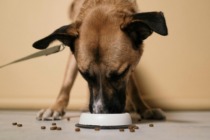
DogFoodAdvisor is reader supported See how
Dog Food Advisor is 100% impartial and is never paid to promote any brand. But if you buy using links on this page, we may earn a referral fee.
If you’re trying to manage weight or perhaps you suffer from stomach issues or allergies, you’ve probably tried one of the various diets floating around. Carnivore, Paleo, Keto, Vegan, Blood type, Gluten-free, Zone Diet, the list goes on.
While these diets tend to focus on what you eat, Intermittent Fasting focuses on when you eat. Essentially, it’s an eating pattern that is split into periods of eating and fasting. You don’t limit what you consume but control when you consume it.
Many people say they reap the benefits of intermittent fasting, but are there any benefits of your dog fasting? Most dogs will eat one or two meals a day, but some benefit from more or less — it just depends.
It’s an interesting topic and one worth exploring. So, with help from our in-house nutritionist, Laura Ward, we wrote an article on the benefits and challenges of intermittent fasting for dogs.
What is intermittent fasting for dogs?
Intermittent fasting works by prolonging the period when your body has burned through the calories consumed during your last meal and begins burning fat.
Humans who have tried the eating plan themselves and tried it with their dogs have claimed tons of benefits. These include improved heart health, physical performance, and reduced obesity. Other reports suggest temporarily fasting could help your dog with certain stomach issues, and some dogs are well-suited to eating just once a day.

Intermittent fasting for dogs mimics the natural eating patterns of wild dogs and wolves, who typically hunt and eat in a feast-or-famine pattern. Therefore, those who believe dogs should follow their ancestral habits might have their dog follow this plan.
However, dogs have been living with humans for centuries and as you know, are becoming more human by the day! Their dietary needs and habits now more closely mirror ours, making direct comparisons to wolves a little more complex.

How can your dog benefit from intermittent fasting?
“It works for some dogs but not others,” says Laura. “Your dog may thrive on eating once per day. For other dogs, it can be preferable to split their daily food to feed at different times. Whether that’s to manage their hunger, for training, to keep them occupied, or other reasons.”
A small study was conducted where they randomly assigned 10 healthy dogs to three different diets. Dogs in the intermittent fasting group tended to lose more weight and had lower blood glucose and insulin concentrations. 1
A further study found that adult dogs fed once daily showed better average cognitive scores and were less likely to experience gastrointestinal, dental, orthopedic, kidney, and liver/pancreas health issues compared to those fed more frequently. While this study doesn’t establish direct cause and effect, it aligns with previous research in mice and humans suggesting that time-restricted feeding may contribute to improved cognitive function and overall physical health. 2
Other possible benefits include:
- Weight management
Fasting can help dogs burn stored fat for energy, promoting weight loss and preventing obesity-related health problems.
- Improved digestion
Giving the digestive system a break can allow it to rest and reset, which may be beneficial for dogs with sensitive stomachs or digestive issues.
- Reduced inflammation
Fasting can help reduce inflammation throughout the body by lowering insulin levels and triggering processes like cellular repair and autophagy.
- Cellular repair and renewal
Fasting can trigger autophagy, a process where cells remove damaged components and promote the regeneration of healthy cells.
- Improved insulin sensitivity
Fasting can improve the body’s sensitivity to insulin, potentially reducing the risk of developing diabetes and metabolic syndrome.
- Detoxification
Fasting can help the body eliminate toxins by giving the digestive system a break and promoting the removal of toxins stored in fat cells.
How to implement a fasting regime for your dog
Canine obesity is a growing concern among U.S. pet parents, leading some to consider fasting as a potential solution. However, since a dog’s nutritional needs vary based on age, size, activity level, and health conditions, there is no one-size-fits-all all approach. For dogs with a veterinary condition, it’s essential to consult a vet before making any dietary changes.
Intermittent fasting for dogs typically involves feeding one or two large meals per day with fasting periods of 8–24 hours. Some pet parents choose to fast their dogs once or twice a week or even once a month, while others simply extend the time between regular meals.
Enrichment-style feeding, where food is used within puzzles or search games to encourage your dog to use their senses, may still be incorporated into a fasting routine. Many dog parents who use scatter feeding, or food-based search games to slow down meal times and encourage their dogs to search for their food could continue to do this, but maintain a period without food in between each feeding time.
Where enrichment feeding is used more often, or in combination, this is not aligned with fasting. Regular feeding in this manner, although providing other benefits of calming or entertainment for the dog, is more frequent so the fasting period is not maintained.
When is fasting not good for your dog?
An expert should help you determine if fasting is needed or if it’s the best approach for your dog. “Although there is science that suggests once-a-day feeding is beneficial and many dog parents have incorporated such feeding methods over the years, it ultimately comes down to the individual dog.
“It’s also important to note that some dogs can vomit bile when they are hungry so if this starts happening during a fast, it indicates that more regular feeding times suit your dog best,” says Laura.
Although there are no studies on each type of feeding, you should generally avoid fasting puppies. “We initially feed puppies four times a day because their fast growth means they cannot regulate their blood sugar over longer periods of time,” says Laura. “Puppies should continue to be fed smaller meals, regularly, to ensure they receive the nutrition they require for their development.”
If your dog has a recognized health issue, seek advice from your vet as conditions such as diabetes will require blood sugar management and a particular feeding schedule.

Final word
The Dog Food Advisor does not accept money, gifts, samples or other incentives in exchange for special consideration in preparing our reviews.
However, we do receive a referral fee from online retailers (like Chewy or Amazon) and from sellers of perishable pet food when readers click over to their websites from ours. This helps cover the cost of operation of our free blog. Thanks for your support.
For more information, please visit our Disclaimer and Disclosure page.
Article reviewed by
Laura Ward
Pet Nutritionist
Laura studied BSc (Hons) Animal Science with an accreditation in Nutrition at the University of Nottingham, before working for eight years in the pet food and nutrition industry.




